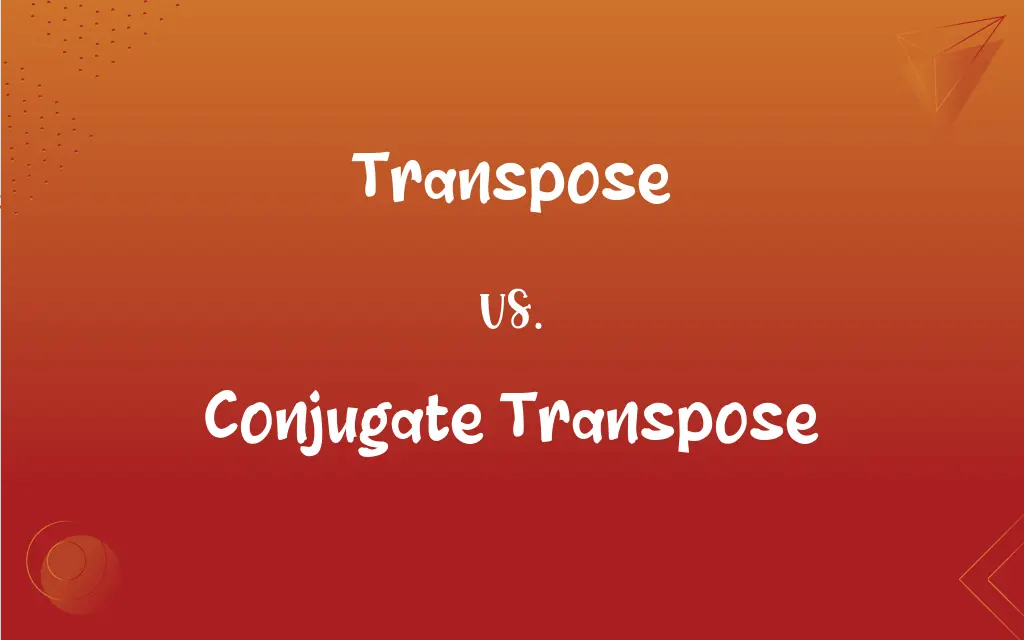Transpose vs. Conjugate Transpose: What's the Difference?
Edited by Aimie Carlson || By Harlon Moss || Published on February 27, 2024
Transpose flips a matrix over its diagonal, whereas conjugate transpose flips and takes the complex conjugate of each element.

Key Differences
The transpose of a matrix involves flipping it over its diagonal, turning rows into columns and vice versa. Conjugate transpose also flips the matrix but additionally takes the complex conjugate of each element.
In the transpose, the elements are rearranged as they are. In contrast, the conjugate transpose not only rearranges the elements but also changes their sign if they are complex numbers.
Transpose is used in various mathematical and computational fields for matrix manipulation. Conjugate transpose is particularly important in fields dealing with complex numbers, like quantum mechanics.
The transpose of a symmetric matrix remains symmetric. The conjugate transpose is crucial in defining Hermitian matrices, where a matrix is equal to its conjugate transpose.
Comparison Chart
Operation
Flips matrix over its diagonal
Flips and takes complex conjugate of elements
ADVERTISEMENT
Complex Numbers
Does not alter elements
Changes sign of imaginary parts
Primary Usage
General matrix manipulation
Important in complex number systems
Relevance to Symmetry
Preserves symmetry of symmetric matrices
Key in defining Hermitian matrices
Transpose and Conjugate Transpose Definitions
Transpose
Transpose of a matrix rearranges its rows into columns.
The transpose of a 2x3 matrix results in a 3x2 matrix.
Conjugate Transpose
Conjugate transpose flips a matrix and takes the complex conjugate of each element.
In quantum mechanics, conjugate transpose is used to describe wave functions.
ADVERTISEMENT
Transpose
Transpose changes the orientation of a matrix.
In graphics, transpose operations can rotate image matrices.
Conjugate Transpose
Conjugate transpose is crucial in complex number systems for matrix operations.
It's used in signal processing to handle complex signal matrices.
Transpose
Transpose maintains the dimensions of a square matrix.
The transpose of a square matrix rotates it along its diagonal.
Conjugate Transpose
Conjugate transpose changes both orientation and complex elements of a matrix.
In electrical engineering, conjugate transpose assists in analyzing complex circuit matrices.
Transpose
Transpose is a fundamental operation in linear algebra for matrix manipulation.
Calculating the transpose is essential in solving linear equations.
Conjugate Transpose
Conjugate transpose is essential for defining unitary matrices.
A unitary matrix's inverse is its conjugate transpose.
Transpose
Transpose can be used to find orthogonal matrices.
An orthogonal matrix equals its own transpose.
Transpose
To reverse or transfer the order or place of; interchange.
Transpose
(Mathematics) To move (a term) from one side of an algebraic equation to the other side, reversing its sign to maintain equality.
Transpose
(Music) To write or perform (a composition) in a key other than the original or given key.
FAQs
Why is conjugate transpose important?
It's key in complex number systems and quantum mechanics.
What does a conjugate transpose involve?
Flipping a matrix and taking the complex conjugate of elements.
When is transpose used?
In various mathematical and computational fields for matrix rearrangement.
What is a matrix transpose?
It's flipping a matrix over its diagonal.
What happens to a square matrix under transpose?
It maintains its dimensions but changes orientation.
Is conjugate transpose used in signal processing?
Yes, especially with complex signal matrices.
What's an orthogonal matrix in terms of transpose?
A matrix that equals its own transpose.
What's the effect of transpose on symmetric matrices?
They remain symmetric after transpose.
How does conjugate transpose relate to Hermitian matrices?
A Hermitian matrix equals its conjugate transpose.
Can transpose change matrix dimensions?
Yes, except for square matrices.
Does transpose affect the determinant of a matrix?
No, the determinant remains the same after transpose.
Can transpose and conjugate transpose yield the same result?
Yes, for real-number matrices, both operations yield the same result.
Does conjugate transpose affect real numbers?
It treats real numbers the same as a regular transpose.
Is transpose applicable to vectors?
Yes, converting row vectors to column vectors and vice versa.
What is a unitary matrix in terms of conjugate transpose?
A matrix whose inverse is its conjugate transpose.
Does conjugate transpose apply to 1D arrays?
Yes, particularly if they contain complex numbers.
Are conjugate transposes used in quantum mechanics?
Yes, in describing wave functions and operators.
In what scenarios is conjugate transpose more relevant than regular transpose?
In scenarios involving complex number matrices, like in physics or electrical engineering.
About Author
Written by
Harlon MossHarlon is a seasoned quality moderator and accomplished content writer for Difference Wiki. An alumnus of the prestigious University of California, he earned his degree in Computer Science. Leveraging his academic background, Harlon brings a meticulous and informed perspective to his work, ensuring content accuracy and excellence.
Edited by
Aimie CarlsonAimie Carlson, holding a master's degree in English literature, is a fervent English language enthusiast. She lends her writing talents to Difference Wiki, a prominent website that specializes in comparisons, offering readers insightful analyses that both captivate and inform.







































































